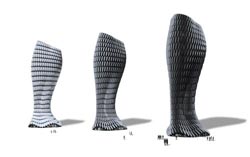Based on the model of the bird-of-paradise flower

Bionic façade shading systems<br><br>University of Stuttgart ITKE<br>
An innovative folding mechanism without joints and hinges: Prof. Dr. Jan Knippers from the Institute of Building Structures and Structural Design (ITKE) at the University of Stuttgart, Prof. Dr. Thomas Speck, Director of the Botanical Gardens at Albert-Ludwigs-University Freiburg, Dr. Markus Milwich from the Institute of Textile Technology and Process Engineering Denkendorf as well as their employees are being presented with the Gips-Schüle Research Prize awarded for the first time for the bionic façade shading system Flectofin® and the further developments based on this.
The award is to be presented by retired Minister of State Erwin Teufel on 23rd October 2013 in Stuttgart. The Gips-Schüle Foundation is endowing the prize with 40,000 Euros and will be awarded every two years in future.
Flectofin® is a changeable construction inspired by nature for architecture: it works like a vertical blind. The direction of the louvers can be changed as required in the case of the infinitely adjustable folding mechanism. However, the researchers have done without wear-prone and high-maintenance joints and hinges. In place of this the elastic deformation is based on the folding mechanism in the blossom of the strelitzias. The flower is pollinated by birds in its home country of South Africa, that settle down on the “perch” formed by the plant made of misshapen petals. Due to the weight of the bird, the petals unfold and the plant releases pollen that the bird transfers to the next blossom.
The basis for the Flectofin® folding mechanism is a plastic reinforced with glass fibre that has highly elastic properties and is very malleable. Opening and closing the louvers is linked with bending a rod integrated in the louver through which it turns down up to 90 degrees. The basic principle can be developed into various versions. Since the folding mechanism works without technical joints or hinges and Flectofin® systems can also be attached to curved facades that are burdensome to shade, the researchers are hoping for an important stimulus for modern architecture. The Flectofin® shading system can be used from detached houses up to large façades measuring up to 20 to 30 metres. The research team was already awarded the “Techtextil Innovation Prize 2011 – Architecture“ for technology by Europe’s largest and most important industrial fair for technical textiles as well as the “International Bionic-Award“ by the Schauenburg Foundation in 2012.
The Gips-Schüle Foundation was set up in 1965 with the assets of the Schüle family that had founded the first gypsum factory in Stuttgart in 1870. Its purpose is to promote applied, multidisciplinary research and teaching as well as young researchers. By awarding this prize the foundation is honouring interdisciplinary research projects with a high degree of innovative potential and sustainable benefits for society.
Further information:
Prof. Jan Knippers, University of Stuttgart, Institute of Building Structures and Structural Design,
Tel. 0711/685-83280, info [at] itke.uni-stuttgart.de
Prof. Thomas Speck, Albert-Ludwigs-University Freiburg, Director Botanical Gardens
Tel. 0761/203-2875, Email: thomas.speck [at] biologie.uni-freiburg.de
Dr. Hans-Herwig Geyer, University of Stuttgart, Head of University Communication and Press Spokesperson,
Tel. 0711/685-82555, Email: hans-herwig.geyer [at] hkom.uni-stuttgart.de
Media Contact
More Information:
http://www.uni-stuttgart.deAll latest news from the category: Awards Funding
Newest articles

A universal framework for spatial biology
SpatialData is a freely accessible tool to unify and integrate data from different omics technologies accounting for spatial information, which can provide holistic insights into health and disease. Biological processes…

How complex biological processes arise
A $20 million grant from the U.S. National Science Foundation (NSF) will support the establishment and operation of the National Synthesis Center for Emergence in the Molecular and Cellular Sciences (NCEMS) at…

Airborne single-photon lidar system achieves high-resolution 3D imaging
Compact, low-power system opens doors for photon-efficient drone and satellite-based environmental monitoring and mapping. Researchers have developed a compact and lightweight single-photon airborne lidar system that can acquire high-resolution 3D…





















